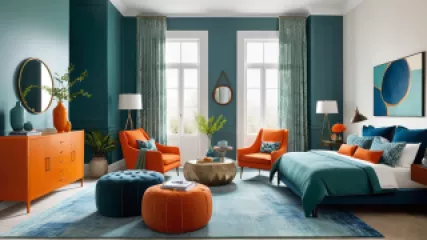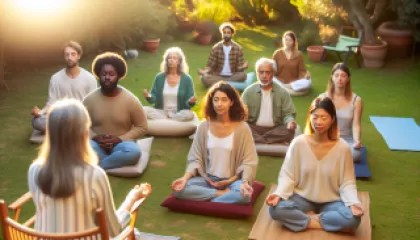Creating Harmonious Color Palettes for Emotional Well-Being in Interior Design
When it comes to interior design, color plays a crucial role in setting the mood and creating a harmonious space. The psychology of color suggests that different colors can evoke various emotions and have a significant impact on our well-being. By understanding the emotional effects of colors, you can make intentional color choices in your interior design to promote emotional well-being. In this tutorial, we will guide you step by step on how to create harmonious color palettes for emotional well-being in interior design.
The Basics of Color Psychology
Before diving into creating color palettes, let's explore the basics of color psychology. Each color has its own psychological associations and can affect our emotions and behavior:
- Red: Symbolizes energy, passion, and excitement. It can stimulate appetite and create a sense of urgency.
- Orange: Represents enthusiasm, creativity, and warmth. It can evoke feelings of comfort and positivity.
- Yellow: Signifies happiness, optimism, and joy. It can enhance focus and stimulate mental activity.
- Green: Symbolizes nature, growth, and harmony. It can create a sense of balance and relaxation.
- Blue: Represents calmness, serenity, and tranquility. It can promote relaxation and improve productivity.
- Purple: Signifies luxury, creativity, and spirituality. It can evoke a sense of mystery and stimulate imagination.
- Neutral Colors: Such as white, gray, and beige, can create a sense of calmness and neutrality.
By understanding the emotional associations of different colors, you can strategically incorporate them into your interior design to achieve the desired emotional impact.
Step 1: Determine the Mood
The first step in creating a harmonious color palette is to determine the mood or atmosphere you want to create in your space. Consider the purpose of the room and the emotions you want to evoke. For example:
- In a bedroom, you might want to create a calm and peaceful atmosphere to promote relaxation and sleep.
- In a home office, you might want to create a focused and productive environment to enhance concentration.
- In a living room, you might want to create an inviting and social atmosphere to encourage interaction.
Identifying the desired mood will guide your color choices and help you create a cohesive color palette.
Step 2: Choose a Dominant Color
Once you have determined the mood, choose a dominant color for your color palette. The dominant color will set the overall tone of the space and serve as the foundation for the rest of the colors. Consider the emotional associations of different colors and select one that aligns with the desired mood. For example:
- If you want to create a calming bedroom, you might choose a soft blue as the dominant color.
- If you want to create an energizing home office, you might choose a vibrant green as the dominant color.
- If you want to create a warm and inviting living room, you might choose a cozy orange as the dominant color.
The dominant color will be the most prominent color in the room, so make sure it resonates with the emotional atmosphere you want to create.
Step 3: Select Supporting Colors
After choosing the dominant color, it's time to select supporting colors that complement and enhance the emotional impact. Supporting colors can be used for furniture, accessories, accent walls, or smaller design elements. Consider the following:
- Analogous Colors: Choose colors that are adjacent to the dominant color on the color wheel. Analogous colors create a harmonious and cohesive look.
- Complementary Colors: Select colors that are opposite to the dominant color on the color wheel. Complementary colors create a vibrant and dynamic contrast.
- Monochromatic Colors: Stick to different shades and tints of the dominant color for a sophisticated and unified color scheme.
- Neutral Colors: Use neutral colors to balance and ground the color palette. Neutrals can help create a sense of calmness and provide a backdrop for other colors to shine.
Experiment with different combinations and consider the proportions of each color in the space. Remember to maintain a balance between bold and subtle colors to ensure a visually pleasing result.
Step 4: Test and Adjust
Before committing to a color palette, it's essential to test and adjust the colors in your space. Paint small swatches of the chosen colors on the walls or use color samples to visualize how they interact with the lighting and other design elements. Pay attention to how the colors make you feel and whether they align with the desired emotional atmosphere.
Additionally, consider the natural light in the room as it can affect the appearance of colors. Natural light tends to bring out the truest colors, while artificial light can cast a different hue. Take these factors into account when finalizing your color palette.
Step 5: Bring in Texture and Patterns
Color is just one element of interior design. To create a visually interesting and engaging space, incorporate texture and patterns alongside your color palette. Texture can add depth and tactile appeal, while patterns can bring energy and visual interest.
Consider using different materials, such as textured fabrics, patterned wallpapers, or textured wall finishes, to enhance the overall design. Ensure that the textures and patterns you choose complement the chosen colors and contribute to the desired emotional atmosphere.
Conclusion
Decorating with mindfulness of color choices is an effective way to promote emotional well-being in interior design. By understanding the psychology of color and following the step-by-step process outlined in this tutorial, you can create harmonious color palettes that evoke the desired emotions and contribute to a positive living environment. Remember to consider the mood, choose a dominant color, select supporting colors, test and adjust, and incorporate texture and patterns. With these principles in mind, you can transform your space into a haven of emotional well-being.
Sources:
"Color Psychology: The Emotional Effects of Colors." Verywell Mind, www.verywellmind.com/color-psychology-2795824.
"The Meaning of Colors in Interior Design." The Spruce, www.thespruce.com/meaning-of-colors-in-interior-design-797983.






